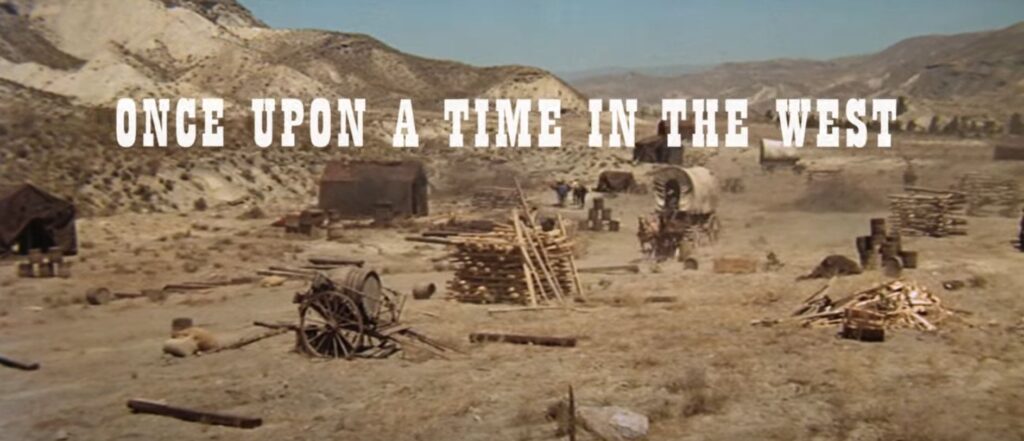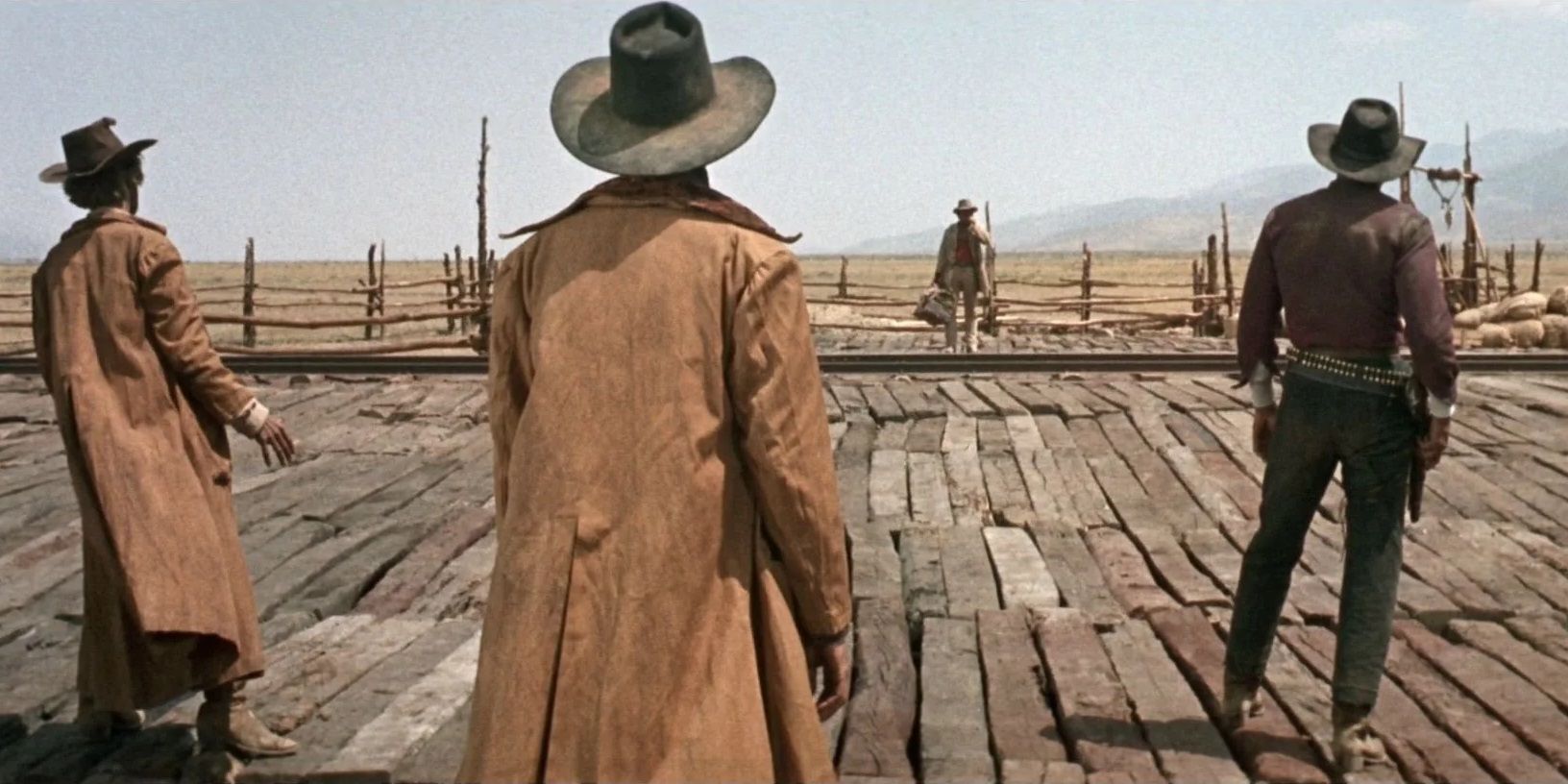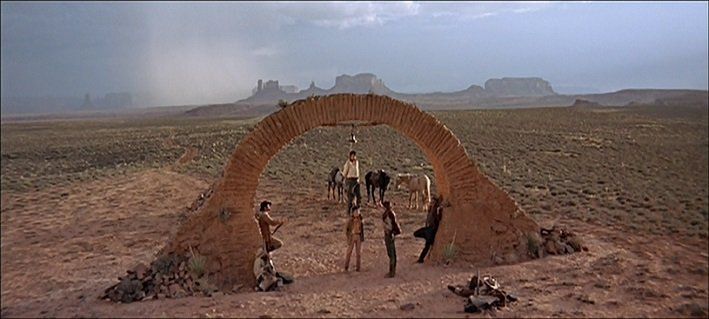
by Jason Sacks
1967’s The Good, the Bad and the Ugly was an unforgettable experience for anyone who saw the film in the theatres. Sergio Leone’s towering Western adventure was one of the most thrilling experiences imaginable, with an astonishing level of craft in cinematography, score, acting, and, of course, the brilliant use of the wide screen.
Under Leone’s towering craftsmanship, Good Bad Ugly was an operatic exploration of betrayal, greed, and anger while also playing with the classic motifs of the tradition of the Western film, with its explorations of frontier justice, the impacts of the Civil War, and – perhaps most famously – with the idea of the lonely man without a name as a key protagonist.
Yes, The Good, the Bad and the Ugly has been one of my all-time favorite films since I first saw it.
Sergio Leoone’s new film, Once Upon a Time in the West, is even better. This might just be my favorite film of the entire 1960s.

I was able to catch West on a quick second run at a local Seattle theatre after a limited release in 1968. And I’m happy to report that everything I loved about Good Bad Ugly is even better in West. The watch was an overwhelming experience for me, one which exists perfectly as both its own work of art and a smart postmodern take on the Western genre itself.
Let’s start with the acting here, because Ugly was the movie which really catapulted the old TV star Clint Eastwood into real stardom. West doesn’t feature Eastwood. But just as Ugly included luminary Western actors Lee Van Cleef and Eli Wallach in roles which emphasized their strongest qualities, West does so with some even more well-known actors.
Perhaps you know the work of some of the leads in this film. It stars leading men like Henry Fonda and Jason Robards in key roles. Charles Bronson, star of so many action films these days, is a brilliant antihero in this film. Three actors appear in the opening sequence who you probably know from classic Westerns: Jack Elam, Woody Strode and Al Mulock.

These actors all add a real heft and energy to the film and help to add to the themes Leone develops here.
But the most important character in the film isn’t one of the male characters. The most important character is a woman: Claudia Cardinale, playing Jill, is the character who truly evolves the most in the film and who drives the societal changes which are so much of what Leone and team are delivering.
Jill is a former New Orleans prostitute, now a wife and mother who moves to the small Arizona town of Sweetwater in the late 1800s. We first meet Jill as she steps off a crowded train (full of farm animals, Native Americans, and sundry other men and women in a characteristic Leone crowd shot). She looks around for her new family to meet her. But nobody is there for her. Jill steps into the station, and as she arranges her transportation, Leone’s camera majestically swoops over the top of the station house as Ennio Morricone’s score majestically swells and we get a widescreen view of a town in the middle of intensive construction, a frontier village in the middle of its boomtown days.
It’s an incredible moment, the equal of anything Leone has ever committed to screen – and yet, he almost tops that scene a moment later as Jill rides in a carriage through Monument Valley and right through a massive crowd scene of the railroad built through the sandy wilderness. Again the music swells, again Leone shows his intensive attention to detail, and again we get a moment which feels like a perfect realization of something we’ve only seen in old photographs.
As it turns out, Jill’s entire family has been massacred by a group of bad men (I won’t ruin any of the shock by telling you who led the massacre), so this single woman has to make her way alone in the west. As she gathers allies and enemies, and intersects with all the petty, self-centered men who cross her paths, Jill almost single-handedly gives the sense of leading the civilizing of the West.

And it is in those themes that Once Upon a Time in the West becomes truly transcendent. As you can extrapolate from the title, this film is about more than mere fact and mere adventure. Oh sure, it has all that and more.
But what makes this film so special is that it is continuously in dialogue with the myth of the West. Sergio Leone is a huge fan of classic Westerns, and an attentive viewer will see visual and thematic references to classics such as Duel in the Sun, High Noon and Shane. All of that is intentional, but perhaps the most heartfelt references are to the films of John Ford.
Ford, of course, is the dean of Westerns, the director of classics such as The Searchers, My Darling Clementine and 1964’s fascinating revisionist Cheyenne Autumn. The French journals like Cahiers de Cinema venerate Ford as one of the great auteurs. Leone clearly agrees with that assessment; in fact, reports say that Leone demanded to film several segments of Once Upon a Time in Ford’s beloved Monument Valley.

Leone wants his film to resonate with both a physical and mythic vision of the West. Revenge is a great motivation for westerns so he gives us Bronson’s character, “Harmonica,” who has an especially vivid revenge story. He wants to give us true villains, as he does with the actor I won’t reveal. He wants to show shifting alliances, and small frontier towns, and brave heroes, and all the set pieces we want to see in a classic Western.
But Leone also wants to mourn the loss of that old West, the world of fights and revenge and pointless machismo. It’s no accident that one of the key characters of the film is Morton (played very well by Gabriele Ferzetti), a monumentally rich man whose body is crippled, who travels in a gilded rail car he can't really leave. Morton is ambitious but limited. He can barely see past the horizons of his own vision.
As it turns out, Jill’s late husband bought Sweetwater to build a train station on their property, and as the complex characters of this film ally with and fight against Morton in turn, the film becomes a fascinating exploration of myth, of the ability to grow and transcend, of how one person can stand up to authority and yet then become an authority herself.

Once Upon a Time in the West is ultimately about embracing the past and looking excitedly at the future, at how the myths of the past end and the hard realities of the future can begin. It’s about the hard work and the emotional and physical pain that go into civilizing a frontier, but Leone’s masterpiece is also about individual people who take on the feeling of myths. The final scene is so gorgeous and powerful, such a strikingly optimistic view of American progress, that I was brought to tears.
There is so much more to explore here, and I think one day someone can write a whole book about the themes and complexity of Leone’s tremendous film. I haven’t touched on the story arc of Cheyenne, the Robards character, nor on the majestic cinematography, or on the astonishing opening sequence.
But I think I’ve busted out the thesaurus enough to convince you to catch this film if you possibly can.
5 stars.





Maybe not my favorite film of the decade — unless something in the nature of a miracle happens during the next four months, that will be "2001" — but a truly great film. The casting of the primary antagonist is a brilliant move, without giving too much away. The opening scene could be the climax of a fine Western, and it's just the beginning here.